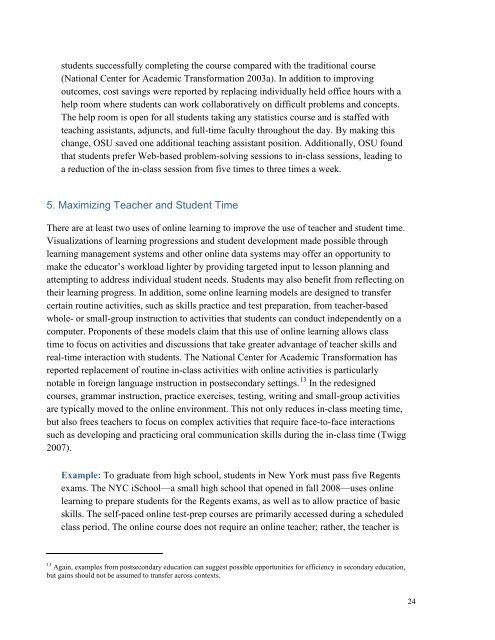Download PDF - SRI International
Download PDF - SRI International
Download PDF - SRI International
You also want an ePaper? Increase the reach of your titles
YUMPU automatically turns print PDFs into web optimized ePapers that Google loves.
students successfully completing the course compared with the traditional course<br />
(National Center for Academic Transformation 2003a). In addition to improving<br />
outcomes, cost savings were reported by replacing individually held office hours with a<br />
help room where students can work collaboratively on difficult problems and concepts.<br />
The help room is open for all students taking any statistics course and is staffed with<br />
teaching assistants, adjuncts, and full-time faculty throughout the day. By making this<br />
change, OSU saved one additional teaching assistant position. Additionally, OSU found<br />
that students prefer Web-based problem-solving sessions to in-class sessions, leading to<br />
a reduction of the in-class session from five times to three times a week.<br />
5. Maximizing Teacher and Student Time<br />
There are at least two uses of online learning to improve the use of teacher and student time.<br />
Visualizations of learning progressions and student development made possible through<br />
learning management systems and other online data systems may offer an opportunity to<br />
make the educator’s workload lighter by providing targeted input to lesson planning and<br />
attempting to address individual student needs. Students may also benefit from reflecting on<br />
their learning progress. In addition, some online learning models are designed to transfer<br />
certain routine activities, such as skills practice and test preparation, from teacher-based<br />
whole- or small-group instruction to activities that students can conduct independently on a<br />
computer. Proponents of these models claim that this use of online learning allows class<br />
time to focus on activities and discussions that take greater advantage of teacher skills and<br />
real-time interaction with students. The National Center for Academic Transformation has<br />
reported replacement of routine in-class activities with online activities is particularly<br />
notable in foreign language instruction in postsecondary settings. 13 In the redesigned<br />
courses, grammar instruction, practice exercises, testing, writing and small-group activities<br />
are typically moved to the online environment. This not only reduces in-class meeting time,<br />
but also frees teachers to focus on complex activities that require face-to-face interactions<br />
such as developing and practicing oral communication skills during the in-class time (Twigg<br />
2007).<br />
Example: To graduate from high school, students in New York must pass five Regents<br />
exams. The NYC iSchool—a small high school that opened in fall 2008—uses online<br />
learning to prepare students for the Regents exams, as well as to allow practice of basic<br />
skills. The self-paced online test-prep courses are primarily accessed during a scheduled<br />
class period. The online course does not require an online teacher; rather, the teacher is<br />
13 Again, examples from postsecondary education can suggest possible opportunities for efficiency in secondary education,<br />
but gains should not be assumed to transfer across contexts.<br />
24
















